| 1 | Cottonmouth |
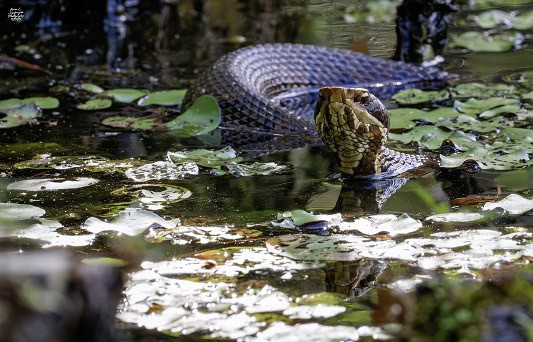
Probably the most feared of all US snakes. Cottonmouths are a widespread species, occurring from central Texas to southeast Virginia, and all the states between. They belong to the same Agkistrodon family as copperheads, but are much more aquatic in nature, and boggy swamps are one of their favourite places to lurk.
Cottonmouths range from 90-120cm, and reach an all-time confirmed record of 189.2cm. A dark brown/black body contrasting against a snowy white mouth lining is their signature ID sign. They have a strong dietary preference for frogs, such as southern leopard frogs, and move at sluggish speeds while slithering along swamp shores. Cottonmouths sometimes shock people by poking their heads up from swamps like a submarine periscope. Dog walkers often bump into them while walking along trails directly adjacent to swamps.
Despite the fear surrounding cottonmouths, life is harder for them than they’d like to admit. They have endless enemies in their swampy habitats, and not many allies. Hungry alligators love to eat them, snapping their jaws shut and disappearing into the depths. The snapping turtle finds cottonmouths simply delicious, and they even have a fish predator in the largemouth bass. Overhead, there’s the beating wings of blue herons and whooping cranes.
Cottonmouths are also less aggressive than commonly believed. They’ve never been filmed charging after people, or leaping from branches to land on people’s fishing boats below. Bites are rare, and even then, the main symptoms are usually local skin tissue destruction and swelling. Either way, the cottonmouth is the swamp snake a Floridian or Georgian is most likely to meet.
| 2 | Red-bellied black snake |
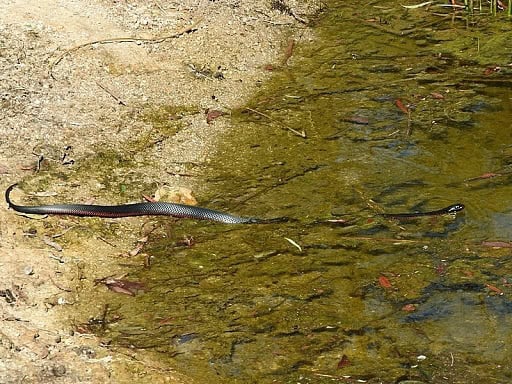
The main Australian swamp snake you should keep an eye out for. Red-bellied black snakes are a dangerously venomous species which are found all over the eastern half of Australia, including near Sydney. They’re a semi-aquatic snake, also frequenting meadows and grassland, but being particularly common in waterbodies, such as boggy swamps filled with years of decaying mulch. Red-bellied black snakes reach a record length of 255cm, and you can recognise them by their red belly contrasting sharply against a completely black body.
Red-bellied black snakes have a mainly amphibian-based diet, including prey like the emerald spotted tree frog. They’re a diurnal species, moving by day, and are excellent swimmers. They use these skills to prowl the swamp surface for frogs, looking for strange, subtle movements which their reptile brains instinctively recognise as hopping.
Red-bellied black snakes can move slowly when necessary, allowing them to blend in with rotting vegetation floating on the swamp surface. When a frog draws near, they suddenly move with a burst of speed. They allow their neurotoxic venom to sink in, then retreat to the swamp’s edge to swallow their meal in peace.
Red-bellied black snakes pull the strings of fate for all frogs in their local swamp, which are sometimes allowed to live based purely on whether they’ve already had a meal in the past 24 hours.
| 3 | Western ribbon snake |
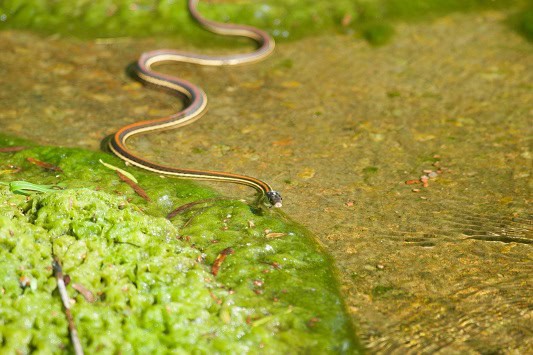
A species of many wet environments: streams, rivers, lakes, and forest swamps filled with decades of slime. Western ribbon snakes (Thamnophis proximus) are an extremely widespread species, ranging from Chicago through Texas and Mexico all the way to Costa Rica.
This is one of the most likely swamp snakes for a US citizen to encounter. They’re not found in remote areas and can easily appear in a swampy forest directly adjacent to your back garden. But even the densest swamps surrounded by muck and twisting vegetation are acceptable living quarters for them.
Western ribbon snakes live in a competitive environment, hunting frogs and red-backed salamanders, while weaving past the hungry attentions of hawks, turtles and milk snakes. As a fellow swamp dweller, the cottonmouth is a confirmed predator, and may be their greatest nemesis of all. Though effective at hunting small hopping prey, western ribbon snakes are far from masters of their swamp ecosystem. Size rules all, and at a record of just 126.8cm, this snake is easily dwarfed by its swampy neighbours.
This species has a mildly venomous saliva, which is barely capable of swelling a human’s hand. Western ribbon snakes are much thinner than their garter snake cousins, and their pale stripes are a light cream rather than yellow. They prefer to capture frogs using speed and agility, rather than the cottonmouth’s stealthy ambush tactics.
| 4 | Common keelback |
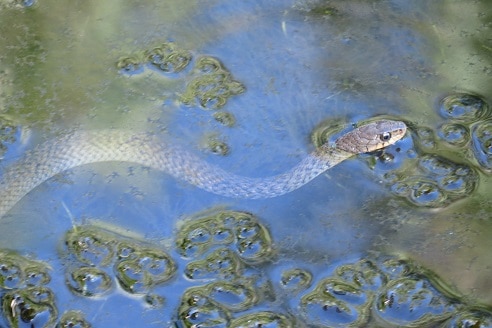
A harmless snake of northeast Australia, which sticks to stationary water bodies such as ponds and swamps. Common keelbacks are non-venomous, and reach a maximum of 93cm. Though barely heard of globally, the common keelback is a regular neighbour of Queenslanders, who probably got bored of seeing them years ago. In winter, they prefer wide floodplains, while summer is swamp season.
Common keelbacks (Tropidonophis mairii) are quite timid around humans, and will sometimes flee at high speeds if startled, swimming to the opposite side of their swamp like a speedboat. Others such as pregnant females will find thick stands of watery vegetation to hide in, or dive below into the swampy depths.
Common keelbacks prey overwhemingly on frogs, with a small smattering of toads, which isn’t surprising given their swamp-loving ways. Species include ornate burrowing frogs and even the poisonous Dahl’s water frog. Other Australian snakes die within minutes after eating this frog, even the moment the frog touches their lips, but the common keelback has innate immunity. This gives them a dream survival advantage: a food that no other local snake can eat.
Though not dangerous, their ability to scoop up meals from their swampy world is unparalleled. This species succeeds in a more humble way. Common keelbacks are usually safe in their swamp strongholds, but they still fall victim to cunning predators, including hawks and owls. Their eggs are also consumed by the slatey grey snake.
| 5 | Blood python |
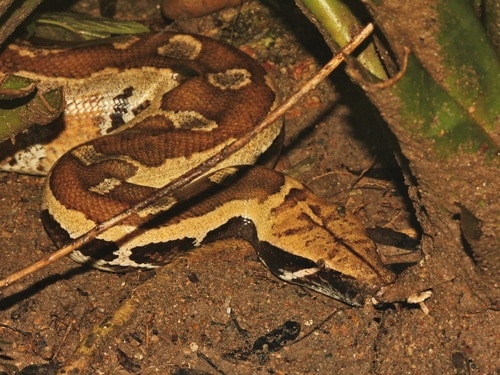
A brutishly thick python, which is typically 90-180cm and reaches a maximum of 2.6 metres. Blood pythons (Python brongsermai) dwell in southern Thailand, peninsular Malaysia and eastern Sumatra, and love swampy areas of forests most of all. This is one of the thickest-bodied pythons of all, with explosive brute force as it lunges against your legs. Because of its fancy colours, this is one of the most popular snakes in captivity worldwide.
Though non-venomous, blood pythons have brutally sharp fangs, which they sink into people’s legs without remorse, with a thuggish gleam in their eyes. Those in Malaysia are more aggressive, while the Sumatran versions are calmer. The signature bloody patterns give them great disguise in their swampy realms, with some patches resembling fallen jungle leaves and the darker patches resembling swampside mulch. This is a pure ambush snake, which rests motionless for days or even weeks by the swamp’s edge. Rodents are overwhelmingly their main prey.
Blood pythons are also drawn to palm oil plantations and their shady canopies, particularly if these are adjacent to swampy forests. Not surprisingly, most trappers hoping to sell them overseas head to these plantations first, with no wish to sink knee-deep into a swampy quagmire. Blood pythons probably encounter humans more today than they did in pre-industrial times, as no sane person would head to their forested swamp lairs willingly.
| 6 | Plain-bellied water snake |
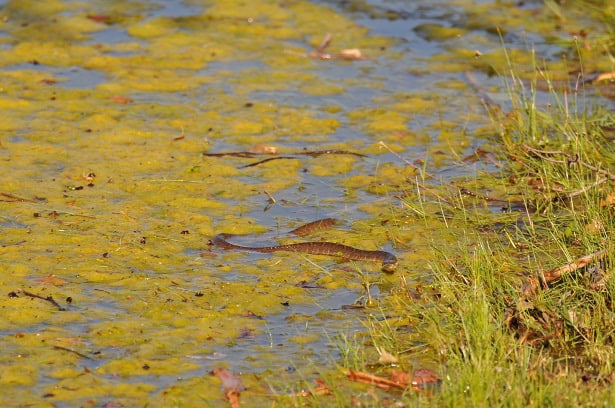
This 75-120cm snake (max 163.6cm) can be found all over the southeastern US, except for Florida, where they only inhabit parts of the panhandle. They lack venom, but can turn surprisingly aggressive if handled. Plainbelly watersnakes (Nerodia erythrogaster) are found in Texas, Georgia, Alabama and the Carolinas alike. As the name suggests, they’re recognisable by a bright belly with no patterns, which differentiates them from northern watersnakes nearby.
Plainbelly watersnakes mainly prey on frogs and toads, such as American bullfrogs, squirrel treefrogs, and southern toads. Compared to their Nerodia watersnake cousins, plainbelly watersnakes are the most likely to be found in swamps. Northern watersnakes (Nerodia sipedon) are less adventurous, sticking to their rivers and crystal clear lakes. However, studies show that plainbelly water snakes stray significantly further from their home water bodies, often moving 100s of metres to upland areas in forests. This makes them much more likely to settle down into a boggy swamp for a few days, before moving on again.
It’s even possible that you could find a plainbelly watersnake living in your local swamp one day, only for it to have mysteriously disappeared the next day. A teenager could bring along his mates to his local forest swamp, insisting that he’d seen snakes in there yesterday, only to be laughed at as nothing happens.
| 7 | Dice snake |
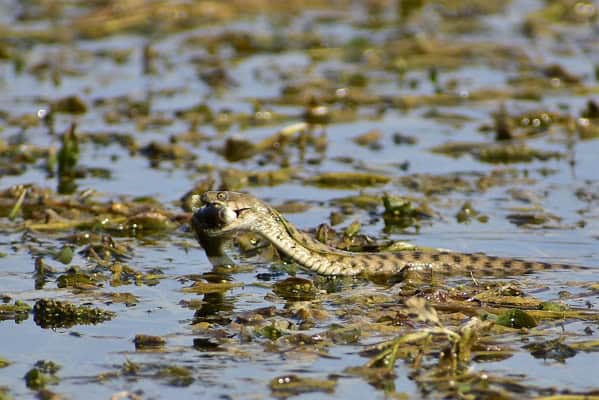
A mildly venomous, semi-aquatic snake, which appears in the lakes, rivers and swamps of central Europe eastwards. Countries where you’ll find the dice snake (Natrix tessellata) include Germany, Slovakia, northern Italy, Bulgaria, Turkey and even Israel. The dice snake reaches a record of 137.1cm, and is finely tuned for blending into aquatic environments, disappearing into lakes and green, slimy swamps equally well. Their scales are a mixture of green and black, with subtle pale patches, a scheme which is identical on their head. In the right locations, these are such a match for boggy swamp mulch that the dice snake becomes practically invisible.
This is an abundant snake, with hundreds in certain locations, yet it’s still perfectly possible to walk right past a dice snake hotspot and not realise. You could see a strange pair of eyes in a swamp, look back and then see nothing, causing you to question your own sanity.
Dice snakes mainly feed on fish with a side helping of frogs. They’re capable of inflicting swelling in humans, and have a deceptive trick where they spew blood from their own mouths to feign death. Dice snakes are non-aggressive, and won’t slither directly up to you and attack. This swampy snake will only inject venom into you if you foolishly pick it up.
If for some reason you’ve decided to live in a swamp, or by a swamp, the dice snake isn’t a creature you need to fear.
| 8 | Yellow-bellied liophis |
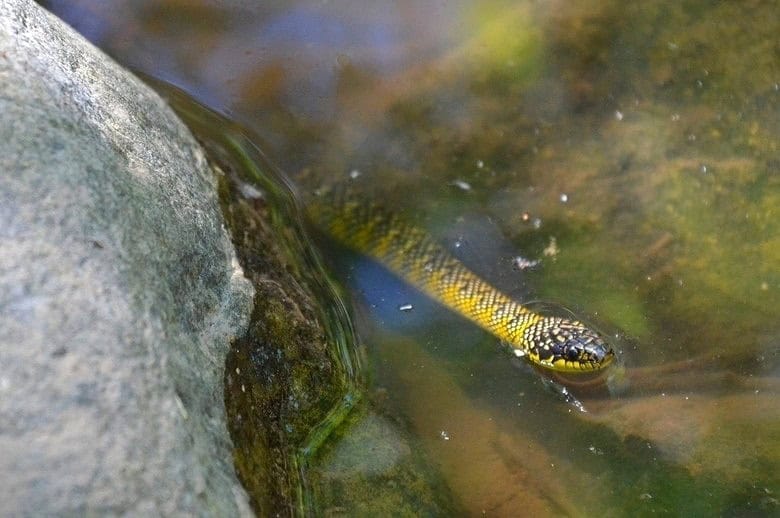
A friendlier-looking swamp snake, with large black eyes and a reasonable facial expression, rather than a cruel crocodilian snarl. The yellow-bellied liophis (Erythrolamprus poecilogyrus) is found in southern Brazil, Argentina and Paraguay, where they’re an extremely abundant and common snake. They mostly stick to wet areas, and swamps within forests are an especially common place to find them lurking. With bright yellow scales contrasting against black, they easier to spot amid the green slime than some other swamp snakes.
This species is sometimes known as the yellow-bellied swamp snake as well. Their swampy ways have led to a swampy diet, as 98% of their meals consists of frogs and toads. The yellow-bellied liophis is mildly venomous, but has never caused a death in humans.
That said, we don’t know everything about the snake kingdom. Erythrolamprus poecilogyrus in particular have very little research about their personality, their tricks and schemes. This may be a deceptive snake that swims to the centre of swamps and looks back calmly, as though trying to send you a message. Suddenly, as you wade deeper into the water out of curiosity, you feel a pressure around your legs: the yellow-bellied liophis was in league with the local anaconda, which is now pulling you down to your certain demise.
The last thing you’d see would be the yellow-bellied liophis skirting to the edge of the swamp to seduce someone else. We’re not saying this will actually happen (necessarily), just to keep your wits about you near snake-infested swamps.
| 9 | Mud snake |
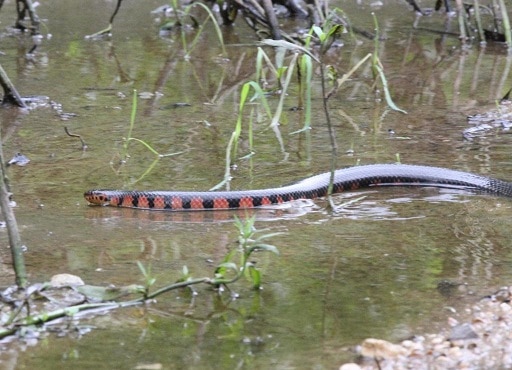
A semi-aquatic species of the southeastern US, which you’re most likely to find in dark Floridian swamps. Mud snakes measure 90-120cm, with a record of 207.0cm, and might be the most harmless large snake in the USA. They’re completely non-venomous, and even attempting to bite is exceptionally rare. You can wade into a swamp, pick one up with your hands and suffer no ill effects at all, except maybe 20 alligators suddenly arriving at once.
The swampy expanses of the everglades are a paradise for this snake, as are twisting cypress corridors also popular with alligators. Mud snakes aren’t hard to find if you live rurally, though they do like the darkest, eeriest swamps. They mostly prey on amphibians, such as the three-toed amphiuma and mole salamanders. They’re sometimes swallowed themselves by cottonmouths, their fellow swamp lover.
Harmless they may be, but mud snakes can look very eerie at times. At dusk, when the fading light reduces the visibility of this already dark snake, casting shadows over their swamps, the effect can be like a 1950s horror film. They also have a disturbing tendency to float motionless on the water surface, coiled in a complete circle. Many people’s quest to find a mud snake would end right there, as they ran screaming back to their car.
| 10 | Orange-bellied swamp snake |
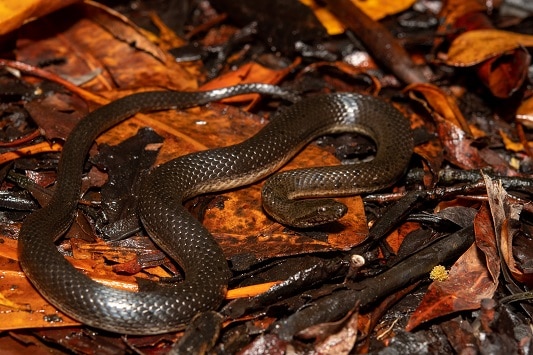
A dedicated snake of central American rainforests, including Costa Rica, Honduras and Nicaragua. Orange-bellied swamp snakes (Tretanorhinus nigroluteus) are non-venomous and have no human deaths to their name, or even serious injuries. They can be found swimming casually around the surface of swamps, searching for their meal, which mainly includes fish and frogs. Their swampy adaptions include upturned nostrils, which allow them to submerge and poke only the tops of their heads up while still breathing.
Rather than swamps near your back garden, orange-bellied swamp snakes dwell in boggy swamps in the most inhospitable, humid jungles. Even reaching this snake is a nightmare. First you have to slash your way through dense foliage, then there’s thick bogs which you could sink in up to your boots. The branches overhead are home to shrieking monkeys, issuing warning cries to their fellow kind. At the swamp itself, the journey might end up being in vain. Orange-bellied swamp snakes are shy, and won’t simply appear at your request.
Orange-bellied swamp snakes average at 55cm and reach up to 89cm. They have mainly murky patterns, rather than neon orange, which are perfect for blending into swamp edges. The swamp is central to their survival as well; when threatened, their default is to dive deep below the surface. Generally, they spend their days in the swamp itself, and their nights prowling the shores.
